The global jerry cans market is valued at USD 2.9 billion in 2025 and is slated to reach USD 5.6 billion by 2035, recording an absolute increase of USD 2.7 billion over the forecast period. This translates into a total growth of 93.1%, with the market forecast to expand at a compound annual growth rate (CAGR) of 6.8% between 2025 and 2035. As reported in Future Market Insights (FMI)’s verified packaging intelligence series, covering sustainability and material lifecycle trends, the overall market size is expected to grow by nearly 1.93X during the same period, supported by increasing demand for liquid storage and transportation solutions in industrial applications, growing adoption of fuel-efficient container designs in automotive sectors, and rising preference for durable chemical-resistant containers across hazardous material handling and emergency supply distribution applications.
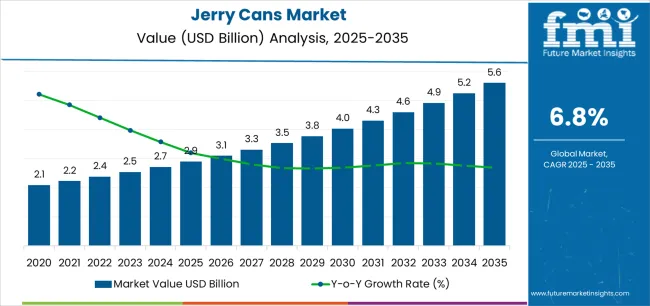
Between 2025 and 2030, the jerry cans market is projected to expand from USD 2.9 billion to USD 4.1 billion, resulting in a value increase of USD 1.2 billion, which represents 44.4% of the total forecast growth for the decade. This phase of development will be shaped by increasing automotive aftermarket demand requiring portable fuel containers, rising adoption of high-density polyethylene materials, and growing demand for UN-certified jerry cans with enhanced safety characteristics. Industrial distributors are expanding their jerry can sourcing capabilities to address the growing demand for chemical transportation, lubricant storage, and emergency fuel supply requirements.
| Metric | Value |
|---|---|
| Estimated Value in (2025E) | USD 2.9 billion |
| Forecast Value in (2035F) | USD 5.6 billion |
| Forecast CAGR (2025 to 2035) | 6.8% |
From 2030 to 2035, the market is forecast to grow from USD 4.1 billion to USD 5.6 billion, adding another USD 1.5 billion, which constitutes 55.6% of the overall ten-year expansion. This period is expected to be characterized by the expansion of lightweight composite jerry can technologies, the integration of tamper-evident closure systems, and the development of stackable container designs with optimized storage performance. The growing adoption of advanced injection molding systems will drive demand for jerry cans with superior impact resistance capabilities and compatibility with automated filling equipment across manufacturing facilities.
Between 2020 and 2025, the jerry cans market experienced robust growth, driven by increasing demand for portable liquid storage solutions and growing recognition of jerry cans as essential containers for fuel handling, chemical transportation, and water storage across military, industrial, and consumer applications. The market developed as manufacturers recognized the potential for jerry cans to provide secure liquid containment during transportation while maintaining robust construction characteristics and enabling regulation-compliant storage formats. Technological advancement in blow molding processes and barrier layer technologies began emphasizing the critical importance of maintaining leak-proof sealing and container durability in harsh operating environments.
Market expansion is being supported by the increasing global demand for industrial liquid handling solutions and the corresponding need for containers that can provide superior chemical resistance and structural integrity while enabling safe transportation and regulation-compliant storage across various industrial and commercial applications. Modern industrial facilities and logistics providers are increasingly focused on implementing container solutions that can safely transport hazardous liquids, prevent contamination, and provide consistent performance throughout demanding handling and storage conditions.
Jerry cans' proven ability to deliver exceptional durability against mechanical stress, enable efficient stacking and storage, and support regulation-compliant handling make them essential container formats for contemporary industrial operations and emergency preparedness applications.
The growing emphasis on workplace safety and hazardous material handling is driving demand for jerry cans that can support industrial safety requirements, improve operational efficiency, and enable certified containment formats. Manufacturers' preference for containers that combine effective liquid containment with regulatory compliance and operational durability is creating opportunities for innovative jerry can implementations. The rising influence of industrial expansion in developing regions and military logistics requirements is also contributing to increased demand for jerry cans that can provide leak-proof sealing, impact resistance, and reliable performance across challenging environmental conditions.
The jerry cans market is poised for rapid growth and transformation. As industries across fuel distribution, chemical handling, water storage, agriculture, and military logistics seek containers that deliver exceptional durability, leak-proof performance, and regulatory compliance, jerry cans are gaining prominence not just as commodity containers but as strategic enablers of safe liquid handling and operational efficiency.
Rising industrial activity in Asia-Pacific and expanding chemical manufacturing sectors globally amplify demand, while manufacturers are leveraging innovations in barrier layer technologies, tamper-evident closure systems, and lightweight material formulations.
Pathways like UN-certified hazardous material containers, anti-static fuel cans, and application-specific customization promise strong margin uplift, especially in high-value segments. Geographic expansion and vertical integration will capture volume, particularly where local production capabilities and distribution network proximity are critical. Regulatory pressures around hazardous material transportation, environmental protection standards, workplace safety requirements, and container certification give structural support.
The market is segmented by material type, capacity, application, closure type, end-use industry, and region. By material type, the market is divided into high-density polyethylene (HDPE), metal (steel and aluminum), and others. By capacity, it covers up to 10 liters, 10-20 liters, and above 20 liters. By application, the market is segmented into fuel & petroleum products, chemicals & solvents, water & beverages, lubricants & oils, and others. The closure type includes screw cap, lever lock, and others. By end-use industry, it is categorized into automotive, chemical & petrochemical, military & defense, agriculture, and others. Regionally, the market is divided into North America, Europe, East Asia, South Asia & Pacific, Latin America, and the Middle East & Africa.

The high-density polyethylene segment is projected to account for 71.5% of the jerry cans market in 2025, reaffirming its position as the leading material category. Industrial distributors and logistics providers increasingly utilize HDPE jerry cans for their superior chemical resistance properties when processed through advanced blow molding technologies, excellent impact strength characteristics, and cost-effectiveness in applications ranging from fuel storage to chemical transportation. HDPE jerry can technology's advanced barrier capabilities and consistent wall thickness formation directly address the industrial requirements for reliable liquid containment in demanding operational environments.
This material segment forms the foundation of modern industrial container operations, as it represents the jerry can type with the greatest versatility and established market demand across multiple application categories and industry sectors. Manufacturer investments in multilayer barrier technologies and drop-test certification continue to strengthen adoption among industrial operators and logistics providers. With companies prioritizing workplace safety and regulatory compliance, HDPE jerry cans align with both performance requirements and economic efficiency objectives, making them the central component of comprehensive liquid handling strategies.
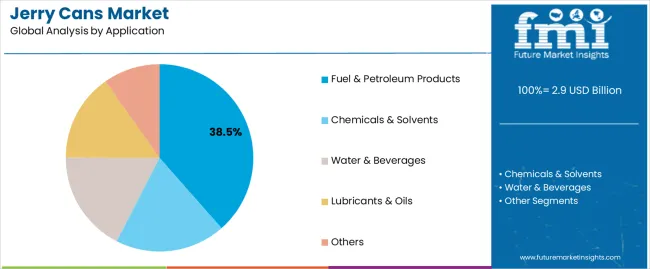
Fuel & petroleum products applications are projected to represent 38.5% of jerry can demand in 2025, underscoring their critical role as the primary industrial consumers of portable fuel containers for automotive refueling, emergency fuel storage, and remote equipment operation. Automotive service providers and industrial operators prefer jerry cans for their exceptional leak-proof capabilities, regulatory compliance characteristics, and ability to safely store flammable liquids while ensuring operational convenience with portable fuel supply. Positioned as essential containers for mobile fuel distribution operations, jerry cans offer both safety advantages and operational flexibility benefits.
The segment is supported by continuous innovation in anti-static material formulations and the growing availability of specialized closure systems that enable tamper-evident sealing with enhanced safety performance and rapid filling operations. Additionally, fuel distributors are investing in fleet management systems to support large-volume jerry can deployment and inventory tracking. As remote industrial operations become more prevalent and emergency preparedness requirements increase, fuel & petroleum products applications will continue to dominate the end-use market while supporting advanced safety feature utilization and distribution efficiency strategies.
The jerry cans market is advancing rapidly due to increasing demand for portable liquid storage solutions and growing adoption of certified container systems that provide superior chemical resistance and structural durability while enabling safe transportation across diverse industrial and commercial applications. However, the market faces challenges, including raw material price fluctuations, competition from alternative container formats, and the need for specialized manufacturing technology investments. Innovation in lightweight composite materials and smart tracking integration continues to influence product development and market expansion patterns.
The growing adoption of UN-certified container designs, hazardous material classification markings, and validated drop-test performance is enabling manufacturers to produce specialized jerry cans with superior regulatory compliance, enhanced safety certifications, and international transportation approval functionalities. Advanced certification systems provide improved hazardous material handling while allowing more efficient cross-border logistics and consistent performance across various regulatory jurisdictions and applications. Manufacturers are increasingly recognizing the competitive advantages of certified container capabilities for market access and premium positioning.
Modern jerry can producers are incorporating RFID tracking tags, IoT sensor integration, and digital inventory management systems to enhance supply chain visibility, enable asset tracking capabilities, and deliver value-added solutions to industrial and logistics customers. These technologies improve operational efficiency while enabling new management capabilities, including real-time inventory monitoring, automated reorder systems, and reduced container loss. Advanced technology integration also allows manufacturers to support large-scale industrial operations and digital transformation beyond traditional manual inventory approaches.
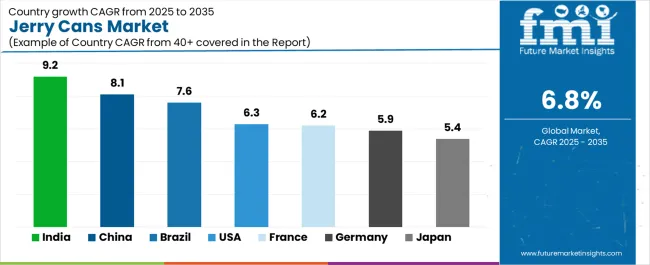
| Country | CAGR (2025-2035) |
|---|---|
| India | 9.2% |
| China | 8.1% |
| USA | 6.3% |
| Brazil | 7.6% |
| Germany | 5.9% |
| Japan | 5.4% |
| France | 6.2% |
The jerry cans market is experiencing strong growth globally, with India leading at a 9.2% CAGR through 2035, driven by the expanding automotive aftermarket sector, growing chemical manufacturing industry, and significant investment in industrial infrastructure development. China follows at 8.1%, supported by rapid petrochemical sector expansion, increasing agricultural mechanization, and growing domestic fuel distribution networks.
The USA shows growth at 6.3%, emphasizing industrial safety compliance and military logistics modernization. Brazil records 7.6%, focusing on agricultural sector expansion and mining industry growth. Germany demonstrates 5.9% growth, prioritizing hazardous material handling standards and advanced manufacturing excellence. Japan exhibits 5.4% growth, emphasizing precision container manufacturing and quality certification systems. France shows 6.2% growth, supported by chemical industry concentration and industrial logistics efficiency.
The report covers an in-depth analysis of 40+ countries top-performing countries are highlighted below.
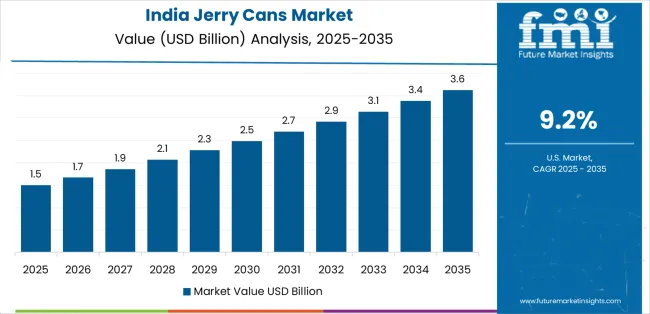
Revenue from jerry cans in India is projected to exhibit exceptional growth with a CAGR of 9.2% through 2035, driven by expanding automotive aftermarket demand and rapidly growing industrial chemical manufacturing supported by government initiatives promoting domestic production development. The country's strong position in agricultural mechanization and increasing investment in fuel distribution infrastructure are creating substantial demand for portable jerry can solutions. Major automotive retailers and industrial distributors are establishing comprehensive jerry can sourcing capabilities to serve both domestic storage demand and export packaging markets.
Revenue from jerry cans in China is expanding at a CAGR of 8.1%, supported by the country's massive petrochemical industry, expanding agricultural mechanization activities, and increasing adoption of certified container systems. The country's government initiatives promoting industrial safety standards and growing middle-class vehicle ownership are driving requirements for sophisticated liquid storage capabilities. International suppliers and domestic manufacturers are establishing extensive production and distribution capabilities to address the growing demand for jerry can products.
Revenue from jerry cans in the USA is expanding at a CAGR of 6.3%, supported by the country's stringent safety regulations, strong emphasis on hazardous material handling protocols, and robust demand for certified containers in industrial and military applications. The nation's mature automotive aftermarket and safety-focused operations are driving sophisticated certified jerry can systems throughout the supply chain. Leading manufacturers and technology providers are investing extensively in UN-certified containers and military-grade products to serve both domestic and international markets.
Revenue from jerry cans in Brazil is growing at a CAGR of 7.6%, driven by the country's expanding agricultural mechanization sector, growing mining operations, and increasing investment in remote industrial development. Brazil's large agricultural base and commitment to industrial resource extraction are supporting demand for portable jerry can solutions across multiple distribution segments. Manufacturers are establishing comprehensive production capabilities to serve the growing domestic market and regional export opportunities.
Revenue from jerry cans in Germany is expanding at a CAGR of 5.9%, supported by the country's chemical industry leadership, advanced safety regulation capabilities, and strategic focus on certified hazardous material containers. Germany's engineering excellence and regulatory compliance culture are driving demand for jerry cans in chemical transportation, industrial equipment servicing, and emergency response applications. Manufacturers are investing in comprehensive certification capabilities to serve both domestic industrial operators and international specialty markets.
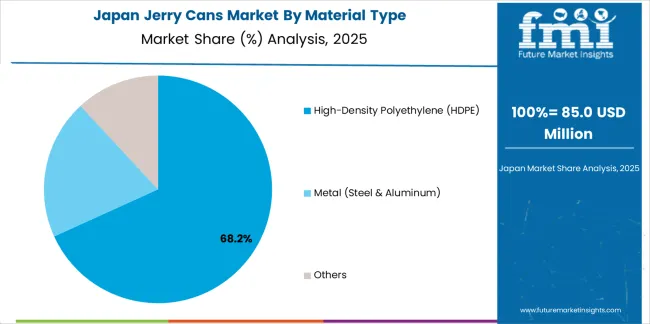
Revenue from jerry cans in Japan is growing at a CAGR of 5.4%, driven by the country's expertise in precision manufacturing, emphasis on quality control, and strong position in automotive aftermarket and specialty container production. Japan's established container technology capabilities and commitment to continuous improvement are supporting investment in advanced manufacturing technologies throughout major industrial centers. Industry leaders are establishing comprehensive quality assurance systems to serve domestic industrial operators and export specialty containers.
Revenue from jerry cans in France is expanding at a CAGR of 6.2%, supported by the country's chemical manufacturing concentration, growing industrial logistics sector, and strategic position in European distribution networks. France's chemical industry capabilities and integrated supply chain infrastructure are driving demand for certified jerry cans in hazardous material transportation, automotive servicing, and industrial facility operations. Leading manufacturers are investing in specialized capabilities to serve the stringent requirements of chemical and industrial sectors.
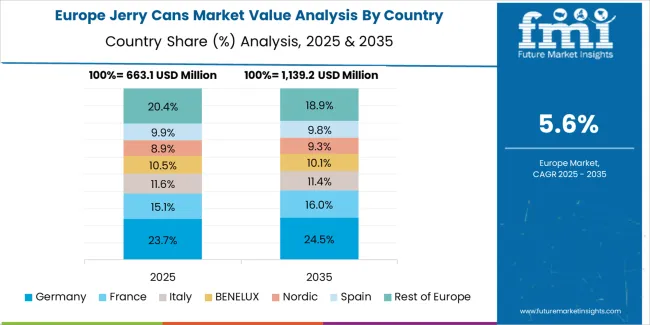
The jerry cans market in Europe is projected to grow from USD 780 million in 2025 to USD 1.5 billion by 2035, registering a CAGR of 6.7% over the forecast period. Germany is expected to maintain its leadership position with a 33% market share in 2025, declining slightly to 32.5% by 2035, supported by its strong chemical manufacturing industry, advanced safety regulation framework, and comprehensive industrial logistics sector serving diverse jerry can applications across Europe.
France follows with a 21.0% share in 2025, projected to reach 21.5% by 2035, driven by robust demand for jerry cans in chemical transportation, automotive aftermarket services, and industrial facility operations, combined with established manufacturing infrastructure and hazardous material handling expertise. The United Kingdom holds a 17% share in 2025, expected to reach 17.5% by 2035, supported by strong automotive aftermarket and growing industrial safety focus. Italy commands a 12.0% share in 2025, projected to reach 12.3% by 2035, while Spain accounts for 7.5% in 2025, expected to reach 7.8% by 2035.
The Netherlands maintains a 4% share in 2025, growing to 4.2% by 2035. The Rest of Europe region, including Nordic countries, Eastern Europe, Belgium, Poland, and other nations, is anticipated to maintain momentum, with its collective share moving from 5.5% to 4.2% by 2035, attributed to increasing industrial development in Eastern Europe and growing chemical manufacturing operations in Nordic countries implementing advanced container management programs.
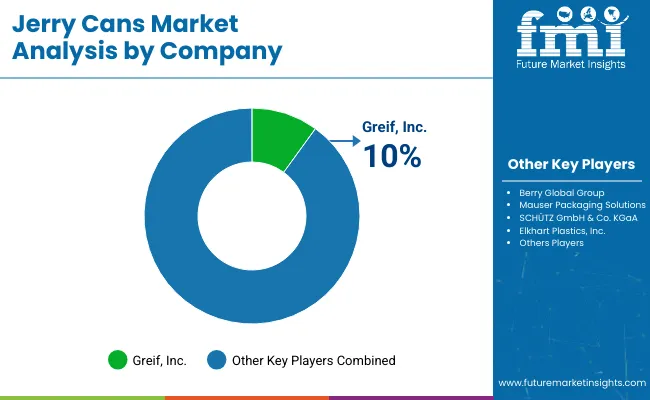
The jerry cans market is characterized by competition among established industrial container manufacturers, specialized liquid storage solution providers, and integrated packaging system suppliers. Companies are investing in barrier technology research, closure system optimization, certification program development, and comprehensive product portfolios to deliver consistent, high-performance, and application-specific jerry can solutions. Innovation in lightweight materials, smart tracking integration, and safety feature enhancement is central to strengthening market position and competitive advantage.
Mauser Packaging Solutions leads the market with a strong market share, offering comprehensive jerry can solutions including UN-certified containers with a focus on chemical and industrial applications. Schutz Container Systems provides specialized industrial container capabilities with an emphasis on hazardous material handling and certified storage solutions. Greif Inc. delivers innovative container products with a focus on industrial liquid handling and metal jerry can technologies. Time Technoplast Ltd. specializes in HDPE containers and blow molding technologies for diverse liquid storage applications. BWAY Corporation focuses on metal container manufacturing and certified fuel can production. Barrier Plastics Inc. offers specialized barrier technology and food-grade certified containers with emphasis on specialized liquid handling applications.
| Items | Values |
|---|---|
| Quantitative Units (2025) | USD 2.9 billion |
| Material Type | High-Density Polyethylene (HDPE), Metal (Steel & Aluminum), Others |
| Capacity | Up to 10 Liters, 10-20 Liters, Above 20 Liters |
| Application | Fuel & Petroleum Products, Chemicals & Solvents, Water & Beverages, Lubricants & Oils, Others |
| Closure Type | Screw Cap, Lever Lock, Others |
| End-Use Industry | Automotive, Chemical & Petrochemical, Military & Defense, Agriculture, Others |
| Regions Covered | North America, Europe, East Asia, South Asia & Pacific, Latin America, Middle East & Africa |
| Countries Covered | United States, Canada, United Kingdom, Germany, France, China, Japan, South Korea, India, Brazil, Australia and 40+ countries |
| Key Companies Profiled | Mauser Packaging Solutions, Schutz Container Systems, Greif Inc., Time Technoplast Ltd., BWAY Corporation, and Barrier Plastics Inc. |
| Additional Attributes | Dollar sales by material type and application category, regional demand trends, competitive landscape, technological advancements in barrier layer systems, closure mechanism development, certification standards evolution, and supply chain integration |
The global jerry cans market is estimated to be valued at USD 2.9 billion in 2025.
The market size for the jerry cans market is projected to reach USD 5.6 billion by 2035.
The jerry cans market is expected to grow at a 6.8% CAGR between 2025 and 2035.
The key product types in jerry cans market are high-density polyethylene (HDPE), metal (steel & aluminum) and others.
In terms of application, fuel & petroleum products segment to command 38.5% share in the jerry cans market in 2025.






Full Research Suite comprises of:
Market outlook & trends analysis
Interviews & case studies
Strategic recommendations
Vendor profiles & capabilities analysis
5-year forecasts
8 regions and 60+ country-level data splits
Market segment data splits
12 months of continuous data updates
DELIVERED AS:
PDF EXCEL ONLINE
Industry Share & Competitive Positioning in Jerry Cans
United States Jerry Cans Market Insights – Demand and Growth Forecast 2025 to 2035
Malaysia Plastic Jerry Can Market Trends & Forecast 2024-2034
Vietnam Plastic Jerry Can Market Analysis – Growth & Forecast 2023-2033
Baritainer Jerry Can Market Size and Share Forecast Outlook 2025 to 2035
Collapsible Jerry Can Market Growth - Size & Forecast 2024 to 2034
Cans Market Analysis – Innovations & Industry Forecast 2025 to 2035
Tin Cans Market
Bowl Cans Market Size and Share Forecast Outlook 2025 to 2035
Market Share Distribution Among Bowl Cans Manufacturers
Food Cans Market
Beer Cans Market
Paint Cans Market Size and Share Forecast Outlook 2025 to 2035
Drink Cans Market Insights - Growth & Trends 2025 to 2035
Market Share Insights of Paint Can Manufacturers
2 Piece Cans Market Size and Share Forecast Outlook 2025 to 2035
Beta-Glucans Market Trends – Growth, Demand & Forecast 2025 to 2035
Industry Share Analysis for 2-Piece Cans Companies
Plastic Cans Market
Aluminum Cans Market Size and Share Forecast Outlook 2025 to 2035

Thank you!
You will receive an email from our Business Development Manager. Please be sure to check your SPAM/JUNK folder too.
Chat With
MaRIA